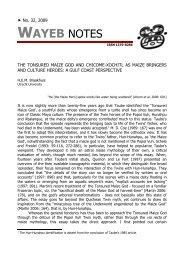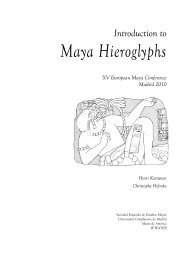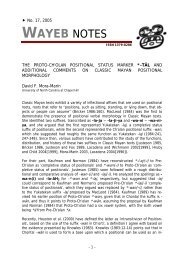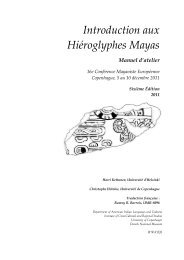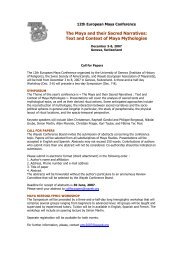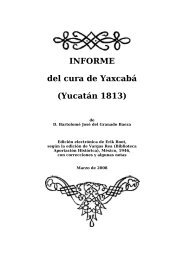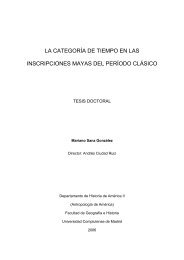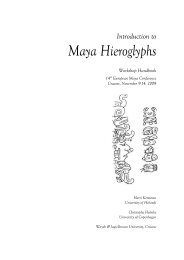Introduction to Maya Hieroglyphs - Wayeb
Introduction to Maya Hieroglyphs - Wayeb
Introduction to Maya Hieroglyphs - Wayeb
Create successful ePaper yourself
Turn your PDF publications into a flip-book with our unique Google optimized e-Paper software.
Kettunen & Helmke 2011<br />
Structure and Content of Texts<br />
Generally, vessels attributed the designation jaay are bowl-shaped and thus bear overall similarity <strong>to</strong> halved<br />
gourds, the probable origin of the term. Nonetheless, few existing cognates exist suggesting that the term fell in<strong>to</strong><br />
disuse after the Classic period. Despite the paucity of relevant linguistic data, Alfonso Lacadena found jay for<br />
“tazón de barro” (“clay bowl”) in Tzotzil (personal communication 2002) suggesting that once ceramic vessels<br />
came <strong>to</strong> replace the original gourd counterparts the term was preserved nonetheless. Based on these analyses the<br />
term *jaay thus seems <strong>to</strong> be a descriptive rather than a functional designation, for “bowls” and originally for<br />
“gourd-shaped bowls.”<br />
jaay yuki’b(iil) / jay yuk’ib(iil)<br />
This vessel type refers <strong>to</strong> vases and bowls, although the latter predominate, as do rounded bases. This vessel type<br />
designation is represented by the compounding of the two terms previously reviewed. In this context, were the<br />
(possessive) pronominal affix absent on the second term and present on the first, the interpretation of “his/her<br />
thin drinking implement” would be supported syntactically. However, these circumstances are not present<br />
suggesting that the adjectival interpretation of jaay should be abandoned.<br />
ulak<br />
This vessel type is used <strong>to</strong> refer <strong>to</strong> flat-based wide-mouthed plates or dishes. The root term remains<br />
problematical, owing <strong>to</strong> the few productive entries but in all occurrences of this term it refers <strong>to</strong> objects that are<br />
generally flat (Reents-Budet 1994: n.24, 101). For example, an unprovenanced jade plaque, apparently a<br />
centerpiece for a necklace (von Winning 1986: Fig. 166) as well as a brick with a modeled-incised text from<br />
Comalcalco (Grube & al. 2002: II-46) are both designated as lak. Instances in which examples of this form contain<br />
the term we’ib (“food implement”) it is clear that it was used as serving vessel for solid foods, we’, “food” being<br />
synonymous in many <strong>Maya</strong> languages with “tamale” (a type of steamed maize dough bread, with vegetable,<br />
turkey or game filling) and “meat” (Zender 1999).<br />
jawante’<br />
This vessel type refers <strong>to</strong> dishes or plates with hollow oven-type tripod supports. Aside from the supports,<br />
vessels with this designa<strong>to</strong>r are identical in most all other respects <strong>to</strong> the lak described above. Stephen Hous<strong>to</strong>n<br />
equated the term with an exact entry in a Colonial dictionary of Yukatek (Perez 1866-77) for hawante: “vasija de<br />
boca ancha y escasa profundidad” (a wide-mouthed vessel of shallow depth) (MacLeod 1990: 300-303). Analyses of<br />
this term allow the identification as the root as the positional jaw > *jäw “face up” (Kaufman & Norman 1984).<br />
However, the original Spanish entry of “boca arriba” should be noted as may more correctly describe the original<br />
semantic domain, as “mouth up.” MacLeod has unders<strong>to</strong>od the suffix –an as a participial, where it is known as a<br />
suffix for positional verbs (Boot 2001), as in chum-w-aan-Ø, “was seated.”<br />
Together this suggests that the term may have originally been intended as jaw-w-an-Ø for “was faced upwards.”<br />
All the few jawante’ documented <strong>to</strong> date are tripod dishes, suggesting that the presence of the tripod supports is<br />
the feature distinguishing these vessels from lak dishes, as otherwise these have all other modal attributes in<br />
common. To date no satisfac<strong>to</strong>ry explanation has been provided for the final suffix –te’. MacLeod speculated that<br />
since the word refers “tree” and “wood” (the primary meaning of this term) that this vessel form may have had<br />
antecedents made of wood, which once made in ceramic, maintained their original designation as if the Late<br />
Classic examples were skeuomorphic (MacLeod 1990: 302-303). However, it should be noted that (as a suffix) –te’<br />
functions, among other things, as a numerical classifier for counts of 20 day period (Boot 2001) and as a suffix <strong>to</strong><br />
the prominent title kalomte’. Based on the attributes surrounding the ascent <strong>to</strong> the rank of kalomte’ and the features<br />
distinguishing lak from jawante’ we would like <strong>to</strong> tentatively suggest that –te’ may be a suffix for things that are<br />
‘s<strong>to</strong>od up’ or ‘made <strong>to</strong> stand up.’ If this interpretation is correct, the term jawante’ may be literally refer <strong>to</strong> a vessel<br />
that is made <strong>to</strong> “face upwards and stand upright.” Based on these analyses it thus seems that the designation of<br />
tripod dishes is essentially descriptive rather than functional.<br />
other vessels<br />
In addition <strong>to</strong> the vessel types examined above, which represent the vast majority of glyphic entries for vessel<br />
types in the inscriptions, roughly twenty additional types have been identified (cf. Boot 2005). These include<br />
35/154



